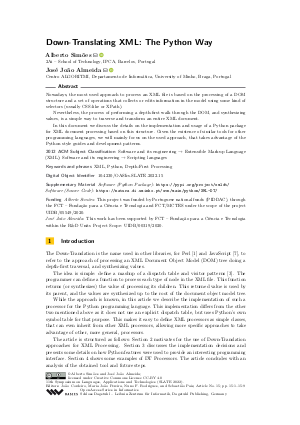Down-Translating XML: The Python Way
Authors
Alberto Simões  ,
José João Almeida
,
José João Almeida 
-
Part of:
Volume:
11th Symposium on Languages, Applications and Technologies (SLATE 2022)
Part of: Series: Open Access Series in Informatics (OASIcs)
Part of: Conference: Symposium on Languages, Applications and Technologies (SLATE) - License:
 Creative Commons Attribution 4.0 International license
Creative Commons Attribution 4.0 International license
- Publication Date: 2022-07-27
File

PDF
OASIcs.SLATE.2022.15.pdf
- Filesize: 0.53 MB
- 9 pages
Document Identifiers
Subject Classification
ACM Subject Classification
- Software and its engineering → Extensible Markup Language (XML)
- Software and its engineering → Scripting languages
Keywords
- XML
- Python
- Depth-First Processing
Metrics
- Access Statistics
-
Total Accesses (updated on a weekly basis)
0PDF Downloads0Metadata Views
Abstract
Nowadays, the most used approach to process an XML file is based on the processing of a DOM structure and a set of operations that collects or edits information in the model using some kind of selectors (usually CSS-like or XPath). Nevertheless, the process of performing a depth-first walk through the DOM, and synthesizing values, is a simple way to traverse and transform an entire XML document. In this document we discuss the details on the implementation and usage of a Python package for XML document processing based on this structure. Given the existence of similar tools for other programming languages, we will mainly focus on the used approach, that takes advantage of the Python style guides and development patterns.
Cite As Get BibTex
Alberto Simões and José João Almeida. Down-Translating XML: The Python Way. In 11th Symposium on Languages, Applications and Technologies (SLATE 2022). Open Access Series in Informatics (OASIcs), Volume 104, pp. 15:1-15:9, Schloss Dagstuhl – Leibniz-Zentrum für Informatik (2022)
https://doi.org/10.4230/OASIcs.SLATE.2022.15
BibTex
@InProceedings{simoes_et_al:OASIcs.SLATE.2022.15,
author = {Sim\~{o}es, Alberto and Almeida, Jos\'{e} Jo\~{a}o},
title = {{Down-Translating XML: The Python Way}},
booktitle = {11th Symposium on Languages, Applications and Technologies (SLATE 2022)},
pages = {15:1--15:9},
series = {Open Access Series in Informatics (OASIcs)},
ISBN = {978-3-95977-245-7},
ISSN = {2190-6807},
year = {2022},
volume = {104},
editor = {Cordeiro, Jo\~{a}o and Pereira, Maria Jo\~{a}o and Rodrigues, Nuno F. and Pais, Sebasti\~{a}o},
publisher = {Schloss Dagstuhl -- Leibniz-Zentrum f{\"u}r Informatik},
address = {Dagstuhl, Germany},
URL = {https://drops.dagstuhl.de/entities/document/10.4230/OASIcs.SLATE.2022.15},
URN = {urn:nbn:de:0030-drops-167617},
doi = {10.4230/OASIcs.SLATE.2022.15},
annote = {Keywords: XML, Python, Depth-First Processing}
}
Author Details
Funding
- Simões, Alberto: This project was funded by Portuguese national funds (PIDDAC), through the FCT – Fundação para a Ciência e Tecnologia and FCT/MCTES under the scope of the project UIDB/05549/2020.
- Almeida, José João: This work has been supported by FCT – Fundação para a Ciência e Tecnologia within the R&D Units Project Scope: UIDB/00319/2020.
Supplementary Materials
- Software (Python Package) https://pypi.org/project/xmldt/
- Software (Source Code) https://natura.di.uminho.pt/svn/main/python/XML-DT/
References
-
José João Almeida and José Carlos Ramalho. XML::DT a perl down-translation module. In XML-Europe'99, Granada - Espanha, May 1999.

-
Steven Bird, Edward Loper, and Ewan Klein. Natural Language Processing with Python. O'Reilly Media Inc., 2009.

- E. Gamma, R. Helm, R. Johnson, and J. Vlissides. Design Patterns: Elements of Reusable Object-Oriented Software. Addison-Wesley Professional Computing Series. Pearson Education, 1994. URL: https://books.google.pt/books?id=6oHuKQe3TjQC.
- Ian Hickson, John Williams, Daniel Glazman, Peter Linss, Elika Etemad, and Tantek Çelik. Selectors level 3. W3C recommendation, W3C, November 2018. URL: https://www.w3.org/TR/2018/REC-selectors-3-20181106/.
-
Daniel Jurafsky and James H. Martin. Speech and Language Processing (2Nd Edition). Prentice-Hall, Inc., Upper Saddle River, NJ, USA, 2009.

- Jonathan Robie, Josh Spiegel, and Michael Dyck. XML path language (XPath) 3.1. W3C recommendation, W3C, March 2017. URL: https://www.w3.org/TR/2017/REC-xpath-31-20170321/.
- Alberto Simões. XML Parsing in JavaScript. In Ricardo Queirós, Mário Pinto, Alberto Simões, José Paulo Leal, and Maria João Varanda, editors, 6th Symposium on Languages, Applications and Technologies (SLATE 2017), volume 56 of OpenAccess Series in Informatics (OASIcs), pages 9:1-9:10, Dagstuhl, Germany, 2017. Schloss Dagstuhl-Leibniz-Zentrum fuer Informatik. URL: https://doi.org/10.4230/OASIcs.SLATE.2017.9.
